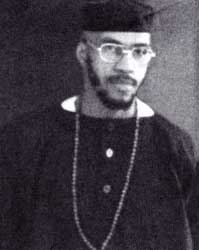Freedom sought for Lucasville Five
By
Sharon Danann
Cleveland
Published Oct 19, 2006 8:36 PM
On
Oct. 12, the American Civil Liberties Union filed a brief in U.S. District Court
seeking a hearing for prison imam Siddique Abdullah Hasan, known in court
documents as Carlos Sanders.
The ACLU
brief was based on exhaustive research by advocate/attorney Staughton Lynd, who
has also written a book about the events, “Lucasville: The Untold Story of
a Prison Uprising,” from which much of the information in this article is
taken.
Hasan had been convicted and
sentenced to death on the testimony of an inmate who stated that Hasan had been
responsible for the decision to kill a guard during the April 1993 rebellion at
the state prison in Lucasville, Ohio. That alleged witness has since recanted
his testimony against Hasan.
The
prosecution had threatened him with a heavier sentence, including a possible
death sentence, if he did not change the facts as he observed them at the time
of the siege to put the blame on Hasan instead. The prosecution knowingly based
its case on perjured testimony. Lynd presents compelling evidence that Hasan was
framed.
In addition to Hasan, four other
men were given the death penalty for their roles as leaders and spokespersons
during the rebellion. Hasan’s case is the closest to exhausting its
appeals.
Justice requires that the
convictions be overturned and that Hasan and his brothers walk
free.
Prior to the rebellion,
overcrowding was making the prison a pressure cooker. Lucasville was designed to
hold 1,540 inmates. When the uprising began, there were 1,820, with 820
“double celled,” including 75 percent of the highest security level
prisoners.
According to findings of an
investigation at the prison, the Southern Ohio Correctional Facility,
“double celling of the inmate population was voiced by a vast majority of
both staff and inmates as a cause of the disturbance.” In addition, one of
the Lucasville Five, Keith Lamar, recalls that the warden had scrapped all the
educational and other positive programs.
Lynd quotes testimony of prisoners that
guards beat prisoners to death, and that weapons and fights among inmates were
common in Lucasville.
Shortly before the
uprising, Hasan was a spokesperson for the Sunni Muslim prisoners on the issue
of TB tests. In one type of test, an injection is used that contains phenol, an
alcohol. Alcohol is prohibited by the Sunni Muslim faith.
The Muslims were willing to undergo
chest X-rays, sputum analysis and urinalysis, all of which are actually more
specific for active TB. But the Lucasville prison warden was prepared to go
ahead with a plan in which Muslim prisoners would be forcibly given the
injection-style TB test. This was to happen on a Monday. The uprising took place
the day before.
Mumia: ‘They did not betray each
other’
In negotiations with
the prison administration during the 11-day siege, Hasan represented the Sunni
Muslims; George Skatzes and Jason Robb spoke for the Aryan Brotherhood. Racial
divisions were set aside and convict unity was forged, resulting in a negotiated
settlement.
Death row journalist Mumia
Abu-Jamal has written about the Lucasville Five: “They rose above their
status as prisoners, and became, for a few days in April 1993, what rebels in
Attica had demanded a generation before them: men. As such, they did not betray
each other; they did not dishonor each other; they reached beyond their prison
‘tribes’ to reach
commonality.”
Hasan and Namir
Abdul Mateen, also known as James Were, were tried in Hamilton County, the
county that includes Cincinnati, even though they were indicted in another
county. Professor James Liebman of Columbia University, in a study of serious
reversible error in capital cases, states that Hamilton County has “the
seventh highest death-sentencing rate in the nation among relatively populous
counties. Hamilton County has twice the death sentencing rate of Cuyahoga County
(Cleveland) and the state as a whole, and nearly three times the death
sentencing rate of Franklin County
(Columbus).”
Cincinnati is
notorious for its racism. The killing of young Black men by Cincinnati police
officers resulted in a Justice Department investigation. It was a hostile venue
for the defendants. In addition, the judge did not allow testimony on prison
conditions that may have caused the
uprising.
Immediately after the
Lucasville uprising, a new category of prisoners was created: “high
maximum security.” The Lucasville Five were among the first inmates to be
transferred to a brand-new supermax prison in Youngstown, Ohio.
A death row cell there is the size of a
parking space for a compact car. The door is solid steel, not bars. Inmates
spend 23 hours a day in their cells. Even so, the prisoners managed to grab some
of the guards and stage a small uprising. The SWAT team that responded beat Robb
until his skull was fractured and he wasn’t recognizable, except by his
tattoos.
Youngstown, now part of the
“Rust Belt,” is home to a cluster of new prisons. The plan is:
demolish the steel mills, throw the workers in jail, and hire other former
steelworkers to be the guards.
A
campaign to free the Lucasville Five is
building.
Messages of solidarity can be
sent, along with stamps and envelopes to facilitate responses, to S.A. Hasan
(#R130-559), Keith Lamar (#317-117), Jason Robb (#308-919) and James Were
(#173-245) at the Ohio State Penitentiary, 878 Coitsville-Hubbard Rd.,
Youngstown, OH 44505-4635.
And to George
Skatzes (#173-501), P.O. Box 788, Mansfield, OH
44901-0788.
Hasan is co-sponsor of the
Web site prisonersolidarity.org and also has a Web site at
www.ohiodeathrow.com/carlos_sanders.htm.
Keith
Lamar has written a book, “Condemned,” which can be obtained from
him at the address above.
Articles copyright 1995-2012 Workers World.
Verbatim copying and distribution of this entire article is permitted in any medium without royalty provided this notice is preserved.
Workers World, 55 W. 17 St., NY, NY 10011
Email:
[email protected]
Subscribe
[email protected]
Support independent news
DONATE


